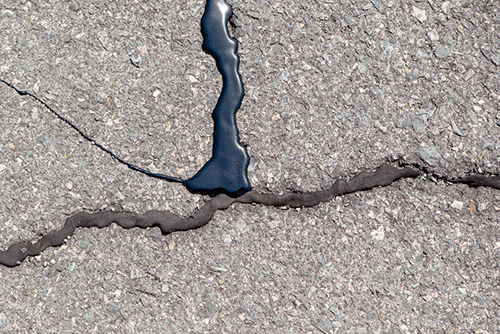Concrete driveways are valued for their longevity and low maintenance. Unfortunately, despite its impressive durability, concrete is not indestructible. Here’s what you should – and shouldn’t do – to avoid driveway repair costs during the winter.
Why Concrete Cracks
All sorts of things can cause your driveway to crack, including too much weight, underlying tree roots, soil movement and, of course, extremely cold weather. Since it is porous, concrete can be breached by rain or snow, which will then expand during freezes and contract once the weather warms. Repeated expansion and contraction from fall to winter can cause a driveway to crack or flake. This is why it is so important to take preventative measures before the temperature drops.
Before Winter
The best way to prevent winter driveway damage is to keep water out in the first place. A quality sealant can boost your driveway’s performance, extend its life and protect it from cracks. Whether it is siloxane or acrylic, the sealant works by keeping water from entering the concrete and preventing expansion and contraction in cold weather. You can easily apply a sealer by rolling or spraying. Just make sure the driveway is very clean and allow the sealer to cure before parking your vehicle. You will also want to reapply sealer every two to five years, depending on the weather in your region.
Before it gets cold, you will also want make sure your driveway includes a slope or drainage system to prevent water from gathering in puddles in or around the concrete. If you aren’t sure, take a good look at how water moves during spring or summertime rain storms. If there is an issue, consider hiring a professional paver to look for possible solutions.
During the Winter
Once cold weather strikes, you need to be careful not to accidentally increase the risk of damage. Some of the most critical “don’ts” include:
- Avoid deicing chemicals. Deicing chemicals can cause spalling, which is when the top layer of concrete begins to peel, flake or chip away. Don’t use de-icing chemicals on your concrete driveway, especially if they contain any type of chloride, which is harsh enough to damage even the toughest concrete.
- Don’t forget to shovel. Make sure to remove snow and ice before it has a chance to melt and seep into the concrete. Stay vigilant and don’t allow snow to sit under the sun. Even if you only miss one day, snow can quickly turn to ice, which is all but impossible to remove without causing at least some damage to your driveway.
- Don’t get too aggressive. You may not think of yourself as a powerful person, but even the slightest individual can wield enough force to chip concrete with the blade of a metal shovel. Make sure to use a plastic shovel, and scoop away snow as gently as possible. Avoid chopping at ice, since this often results in unintended damage.
Alternative Solutions
If you are having a new home built, consider installing an eco-friendly heated driveway snow melt system. If your driveway is already in place, you can look into industrial-sized heating mats, which are placed directly over the top of a driveway and can easily handle the weight of a car. When you consider the average driveway lasts about 25 years, these modern solutions can save you from a ton of backbreaking labor, while reducing the risk of high repair costs.
2-10 HBW offers the most comprehensive Home Warranty coverage for homeowners. Let us help you protect your home.








